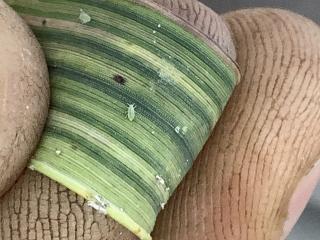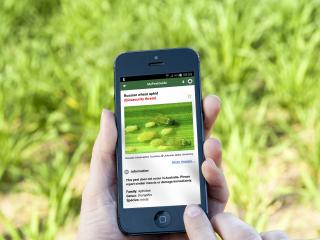Russian wheat aphid found in Esperance region
- North of Esperance

Russian wheat aphid (RWA) has been detected in WA for the first time. So far RWA has been confirmed in two wheat crops north of Esperance. These two crops have since been sprayed with the chemical chlorpyrifos at 1.2L/ha, as per APVMA Permit to minimise spread of RWA. This detection was the result of a vigilant agronomist observing the particular streaking on wheat leaves that are a major symptom of RWA. For more information refer to the DPIRD media statement.
RWA (Diuraphis noxia) is an exotic pest and was first discovered in South Australia in 2016 and then subsequently in Victoria, parts of New South Wales and Tasmania. Since then a lot has been learnt from the research conducted and growers’ experiences interstate about how cereal crops respond to RWA and how best to manage this pest.
Due to the biology of the pest and its ability to spread on the wind eradication of RWA in WA is unlikely.
In 2016 the National Management Group determined that it was not technically feasible or cost-beneficial to eradicate the pest from Australia so the focus on RWA is good management.
How to monitor and diagnose RWA
As the season heads into spring it is expected that an increase in populations of RWA will occur, with rising temperatures.
Inspect the edges of wheat, barley and oat crops, where aphids often colonise first, or where plants are under stress and look for streaking damage near the base of newly emerged leaves.
Other symptoms include; a noticeable loss of green colouration across the crop and, on closer inspection, white, yellow, purple or red streaking, leaf curling, stunted plant growth and loss of vigour in the plant.
Be mindful that damage symptoms from RWA can look similar to herbicide or mite damage, or resemble wheat streak mosaic virus damage symptoms.
RWA adults are only about two millimetres long, pale yellowish green with a fine waxy coating. RWA antennae are short, as are the cone shaped siphunculi (sometimes called cornicles). A hand lens or smartphone macro lens may be useful to see them. For more information refer to the DPIRD Diagnosing Russian wheat aphid page.
As it is difficult to distinguish between aphid species, growers, agronomists and consultants should report all aphid activity using DPIRD’s MyPestGuide™ Reporter app or PestFax Reporter app.
Management and Chemical permits
From early booting to the soft dough stage, a spray application is recommended when more than 10 per cent of tillers are infested with aphids.
If chemical control is required registered insecticide options for RWA currently include: lambda-cyhalothrin, pirimicarb and sulfoxaflor.
Refer to the Australian Pesticides and Veterinary Medicines Authority (APVMA) products and permits databases for all chemical control options available for RWA in grains crops.
Research undertaken by SARDI has found no insecticide resistance.
What should you do if you suspect you have found RWA?

Growers, consultants and agronomists are encouraged to report any suspect detections of RWA or RWA damage to the DPIRD Pest and Disease Information Service on +61 (0)8 9368 3080 or submit a report using the MyPestGuide™ Reporter app or PestFax Reporter app.
Reporting the absence of RWA or RWA symptoms is just as important as reporting the presence of the aphid or symptoms.
DPIRD will be developing a surveillance strategy engaging growers, agronomists, consultants and DPIRD personnel to determine spread of the pest in the grainbelt.
DPIRD will also be enhancing awareness among key stakeholders (e.g., industry members, growers, consultants and agronomists) to maximise the likelihood of early detection.
For more information on RWA refer to the;
- DPIRD Russian wheat aphid: production pest page
- cesar RWA portal page
- GRDC Russian wheat aphid page
- GRDC Just how many Russian wheat aphids is too many podcast.
For more information on RWA or other aphids contact Svetlana Micic, Research Scientist, Albany on +61 (0)427 772 051, Dustin Severtson, Research Scientist, Northam on +61 (0)427 196 656 or Alan Lord, Technical Officer, South Perth on +61 (0)409 689 468.
Article authors: Svetlana Micic (DPIRD Albany) and Cindy Webster (DPIRD Narrogin).
